Originally developed by NexGen as the Nx686, the AMD K6 was supposed to be the first processor in a new CPU family that needed a total of three generations to convince. Only the AMD K6-III and K6-III + series should be able to keep up with the competition of a Pentium II and Pentium III.
Table of contents
- 1 C: B_retro Ausgabe_93
- AMD K6, K6-2 and K6-3
- AMD K6 (1997 to 1999): Model 6 and Model 7
- Specifications
- AMD K6-2 (1998 to 2000): K6-3D for the first time with 3DNow!
- Specifications
- AMD K6-III (1999 – 2001): K6-3D + as the last stage before the Athlon
- Specifications
- C: B_retro Feedback
- Feedback is always welcome
- C: B_retro Review
- An overview of the last fifteen issues
C: B_retro Ausgabe_93
AMD K6, K6-2 and K6-3
After AMD took over the US company NexGen, a developer of microprocessors, on January 16, 1996 and integrated it into the group, the company also transferred and ported the NexGen Nx686 x86 processor, which had already been developed and was first presented as a sample on October 10, 1995 the CPU on the socket 7 used at the time for the Intel Pentium and pin-compatible processors such as the K5. In addition, the Nx686 received the MMX extension.
The first AMD K6 (“Model 6”) was built in 300 nm and appeared on April 2, 1997 as a processor family consisting of the three CPU models AMD K6-166, K6-200 and K6-233, which were positioned against the Intel Pentium MMX and the Pentium II.
The AMD K6-2 from 1998 with later up to 550 MHz was followed by the AMD K6-2 +, K6-3 and K6-3 + from 1999 to 2001. The Athlon then took over with the legendary AMD K7, which was number 1 for gamers for a long time.
AMD K6 (1997 to 1999): Model 6 and Model 7
The first generation of the K6 was introduced in 1997 as Model 6 with three models and was expanded in 1998 by four more models, now manufactured in 250 nm and operated with less voltage. Right from the start, the K6 suffered from its inefficient floating point unit, which was implemented without a corresponding pipeline.
Since the K6 is still based on a NexGen design, it had almost nothing in common with its predecessor K5.
 AMD K6 architecture (image : Appaloosa, CC BY-SA 3.0)
AMD K6 architecture (image : Appaloosa, CC BY-SA 3.0) In addition to the missing pipeline in the floating point unit, which caused problems for the K6, especially in FPU-heavy applications such as 3D games, the new CPU series suddenly found itself helpless in the face of the fast L2 cache of the Intel Pentium II.
In the end, the K6 could not compete on par with the Intel Pentium MMX or the Pentium II and was always the second choice, especially in games.
specifications
The first generation of the K6 processors from AMD came up with a total of seven models that had the following specifications.
Model 6 32 + 32 kilobytes
data + instructions – 2.9 V 17.5 watts AMD K6-200 3.0 V 20.0 watts AMD K6-233 3.2 V 28.5 Watt AMD K6-200 K6
Model 7
(“Little Foot”) 32 + 32 kilobytes
Data + Instructions – 2.2 V 12.5 Watt AMD K6-233 13.5 Watt AMD K6- 266 14.5 watt AMD K6-300 15.5 watt
 AMD K6-233 (” Model 6 “) (Image: Konstantin Lanzet, CC BY-SA 3.0)
AMD K6-233 (” Model 6 “) (Image: Konstantin Lanzet, CC BY-SA 3.0) 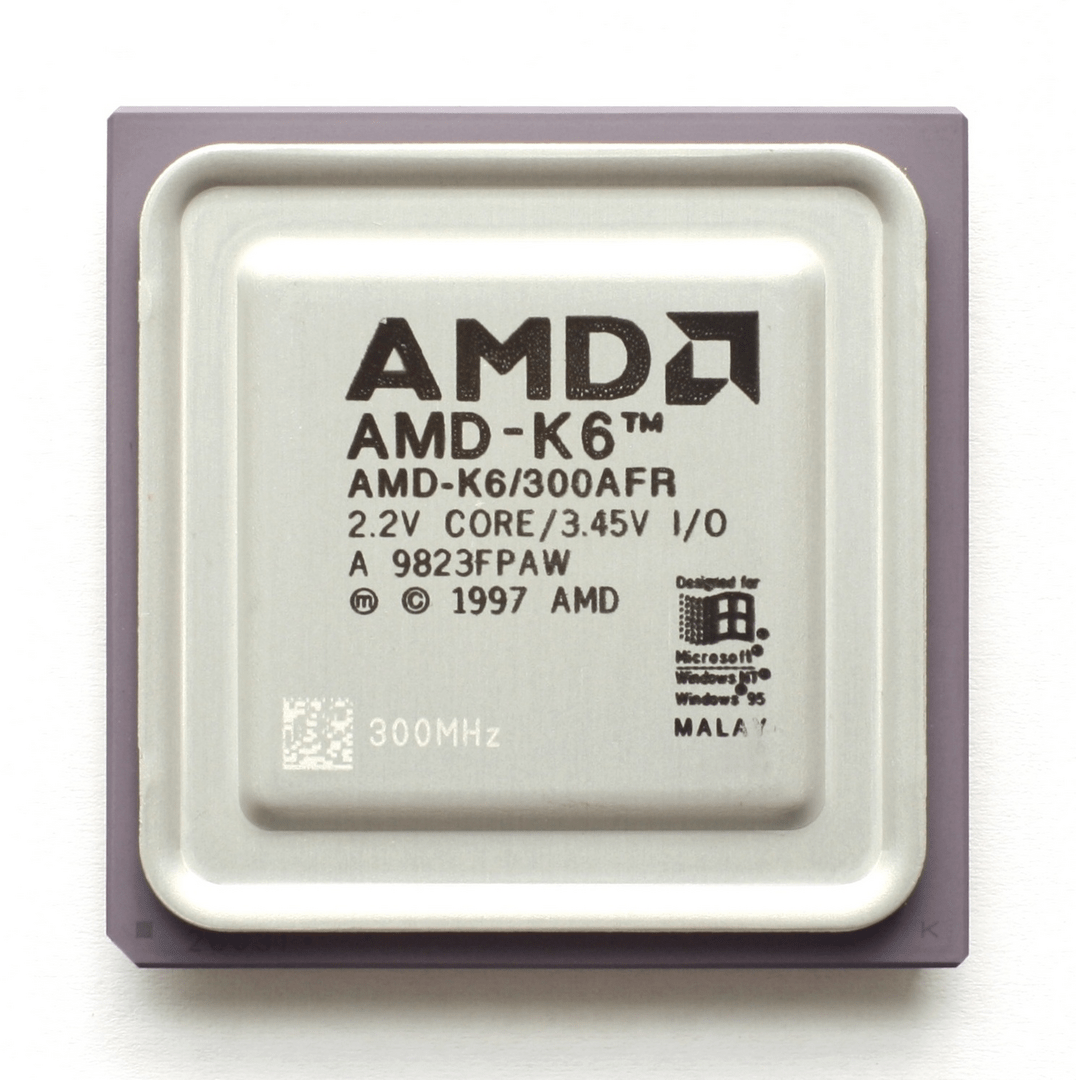 AMD K6-300 (” Model 7 ” ) (Image: Konstantin Lanzet, CC BY-SA 3.0)
AMD K6-300 (” Model 7 ” ) (Image: Konstantin Lanzet, CC BY-SA 3.0) At the latest after the introduction of the Intel Pentium II, it became clear to AMD that there would be no country to be seen against Intel with the first CPU generation based on the K6 architecture. The successor to the K6 was needed, but it was already foreseeable that the architecture would only scale very poorly with high clock frequencies.
AMD K6- 2 (1998 to 2000): K6-3D for the first time with 3DNow!
On May 28, 1998, AMD introduced the K6-3D (“Chomper”), the 2nd generation of the K6 processor as the AMD K6-2.
Again for Socket 7, which has meanwhile been neglected by Intel, was designed and operated with a 66 or 100 MHz fast front side bus (FSB). In addition to the MMX technology taken over by Intel, the 3DNow! used as an instruction set extension.
The four models K6-2-233, K6-2-266, K6-2-300 and K6-2-333 were also supplemented by the new top model K6-2-350 on August 27, 1998. At prices that were in some cases well below those of the Pentium II, the K6-2 was not only able to beat the Pentium MMX, but was also a match for the Pentium II in everyday use. In games and other scenarios that require a strong floating point unit, Intel microprocessors still remain the measure of all things.
In November 1998, AMD responded with a further expansion stage, the Chomper-XT, which should already rely on the improved CPU cores that were used in the K6-3 from 1999, but did not yet have its L2 cache.
With higher clock frequencies, which reached 400 MHz for the first time in November 1998 and 500 MHz in August 1999, AMD remained at least within striking distance of the competition from Intel.
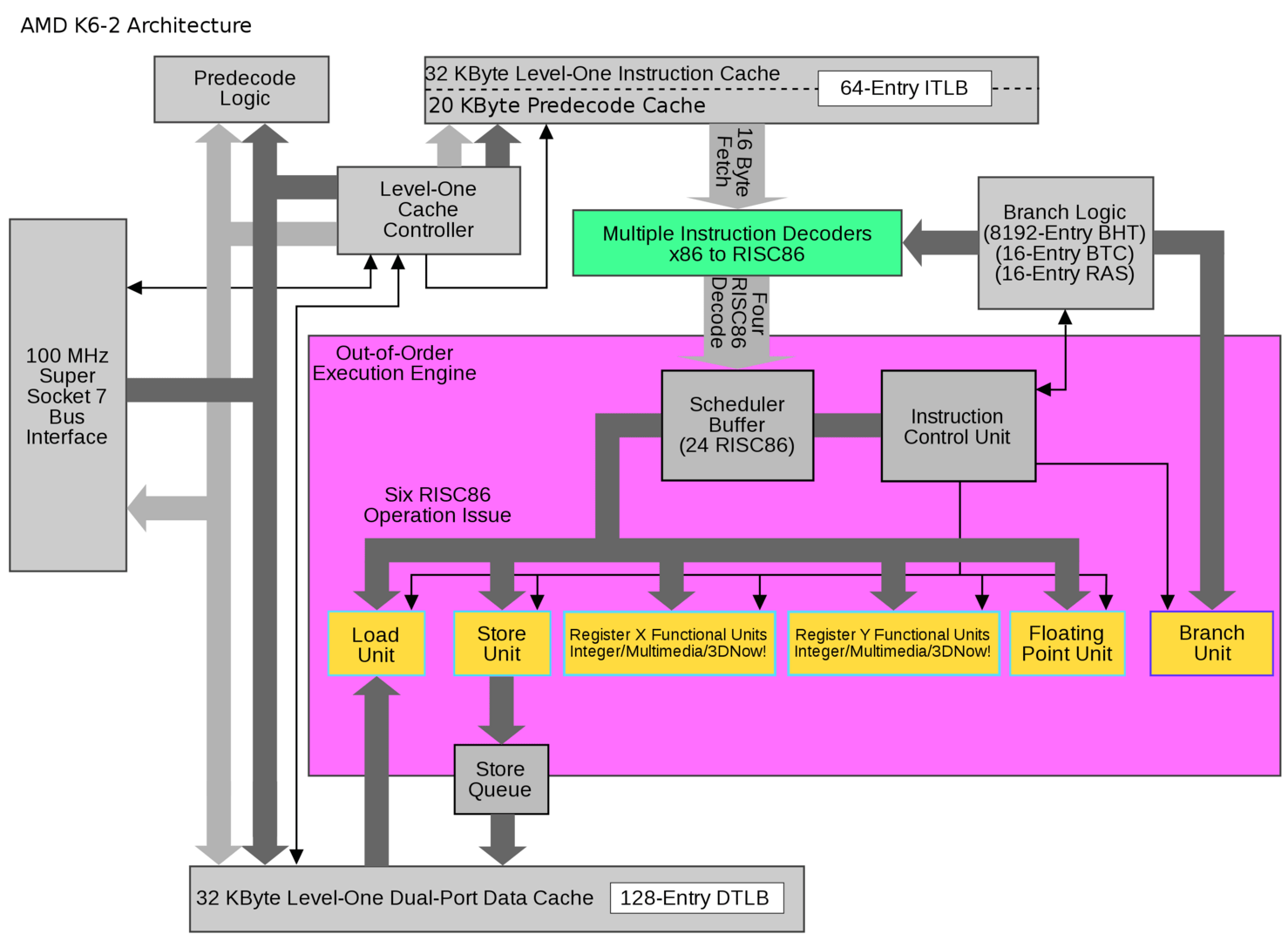 AMD K2-2 – Architecture (Image: Appaloosa, CC BY-SA 3.0)
AMD K2-2 – Architecture (Image: Appaloosa, CC BY-SA 3.0) The AMD K6-2, which is still manufactured in 250 nm, should be up to 550 MHz by February 2000 achieve a TDP of 25 watts and then be replaced by the AMD K6-III, which in turn should submit the missing L2 cache.
specifications
The second generation of the K6 processors from AMD came up with a total of seventeen models that had the following specifications. Compared to the AMD K6, the number of transistors increased from 8.8 to 9.3 million.
(“Chomper”) 32 + 32 kilobytes
data + instructions – 2.4 V 13.5 watt AMD K6-2-266 14.5 watt AMD K6-2-300 17, 5 watt AMD K6-2-333 19.0 watt AMD K6-2-350 20.0 watt AMD K6-2-266 K6-3D
(“Chomper-XT”) 32 + 32 kilobytes
Data + instructions – 2.4 V ??? AMD K6-2-300 ??? AMD K6-2-333 ??? AMD K6-2-350 ??? AMD K6-2-366 20.5 watts AMD K6-2-380 21.5 watts AMD K6-2-400 23.0 watts AMD K6-2-450 28.5 watts AMD K6-2-475 30.0 watts AMD K6-2-500 K6-3D
(“Chomper-XT²”) 32 + 32 kilobytes
data + instructions – 2.2 V 20.5 watts AMD K6-2-533 21.5 watts AMD K6 -2-550 25.0 watts
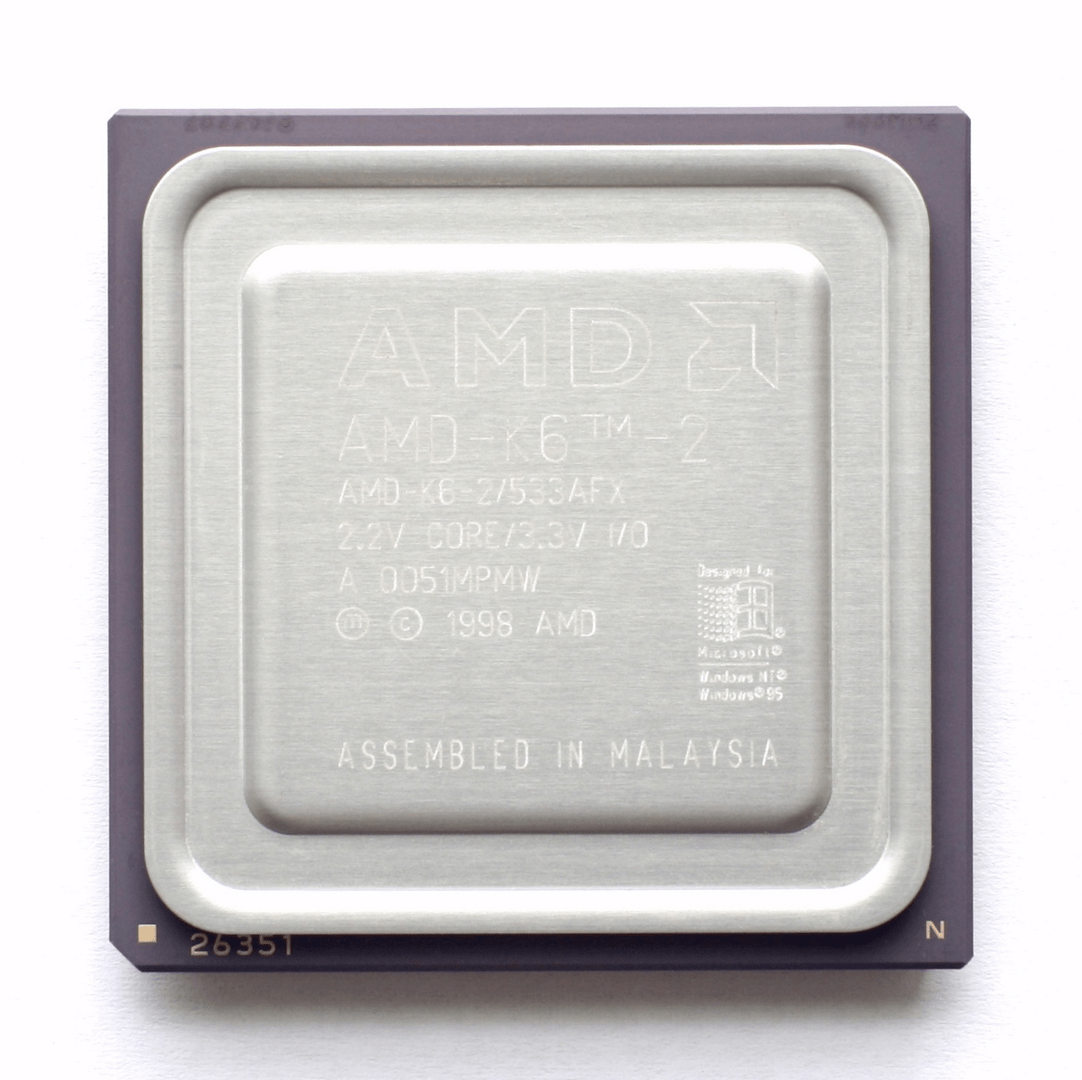 AMD K6-2 (“Chomper-XT”) with 533 MHz (Image: Konstantin Lanzet, CC BY-SA 3.0)
AMD K6-2 (“Chomper-XT”) with 533 MHz (Image: Konstantin Lanzet, CC BY-SA 3.0) After AMD fell behind on the Pentium II with the K6-2 could still not catch up and the Pentium III was already in the starting blocks at Intel, the manufacturer followed up with the 3rd generation K6, the K6-III, at the beginning of 1999 and finally addressed the topic of L2 cache accordingly.
AMD K6-III (1999 – 2001): K6-3D + as the last stage before the Athlon
Like its predecessor, the K6-2, the one on 22. February 1999 first presented K6-III with a total of 64 kilobyte fast L1 cache.
While the K6-2 still relied on a relatively slow connected L2 cache on the mainboard, which in some cases led to significant performance disadvantages compared to the Pentium II and the Celeron (“Mendocino”), the K6-III finally had one with a full CPU clock operated L2 cache, which was accommodated directly on the chip.
The AMD K6-III degraded the L2 cache on the mainboard to an additional L3 cache, which also should help to further shorten the gap to Intel.
But even with the 3rd generation, it remained the same: At that time, Intel CPUs were considered to be clearly superior in terms of floating point Calculations, while the K6-III was ahead of the curve with integer calculations.
In terms of clock frequency, not much was possible with the 3rd draft of the K6 architecture and so the CPUs even had to be operated with a slightly lower clock rate at the beginning. Ultimately, the AMD K6-III should reach up to 570 MHz, but with 21.3 million transistors it was also significantly more complex than the K6 and K6-2.
 AMD K6 (Image: AMD)
AMD K6 (Image: AMD) 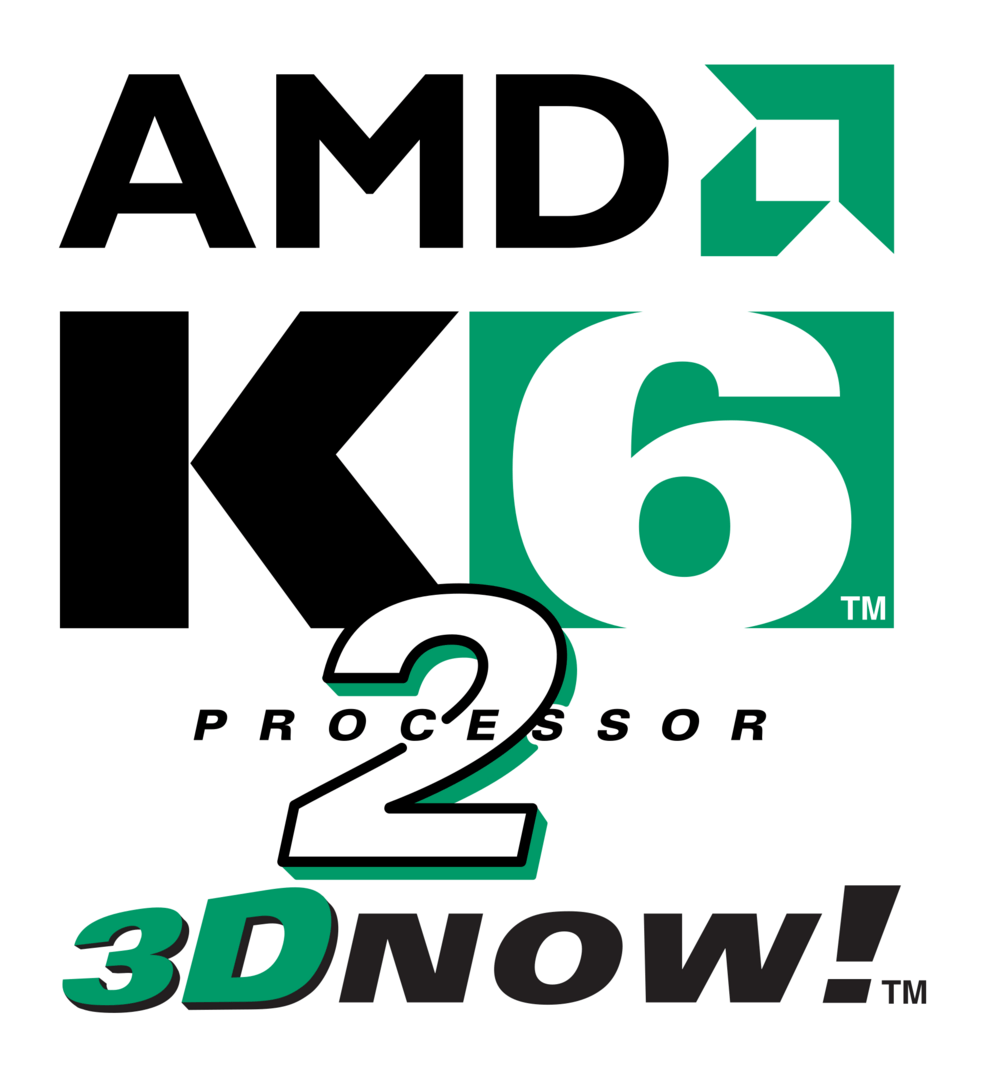 AMD K6-2 (Image: AMD)
AMD K6-2 (Image: AMD) 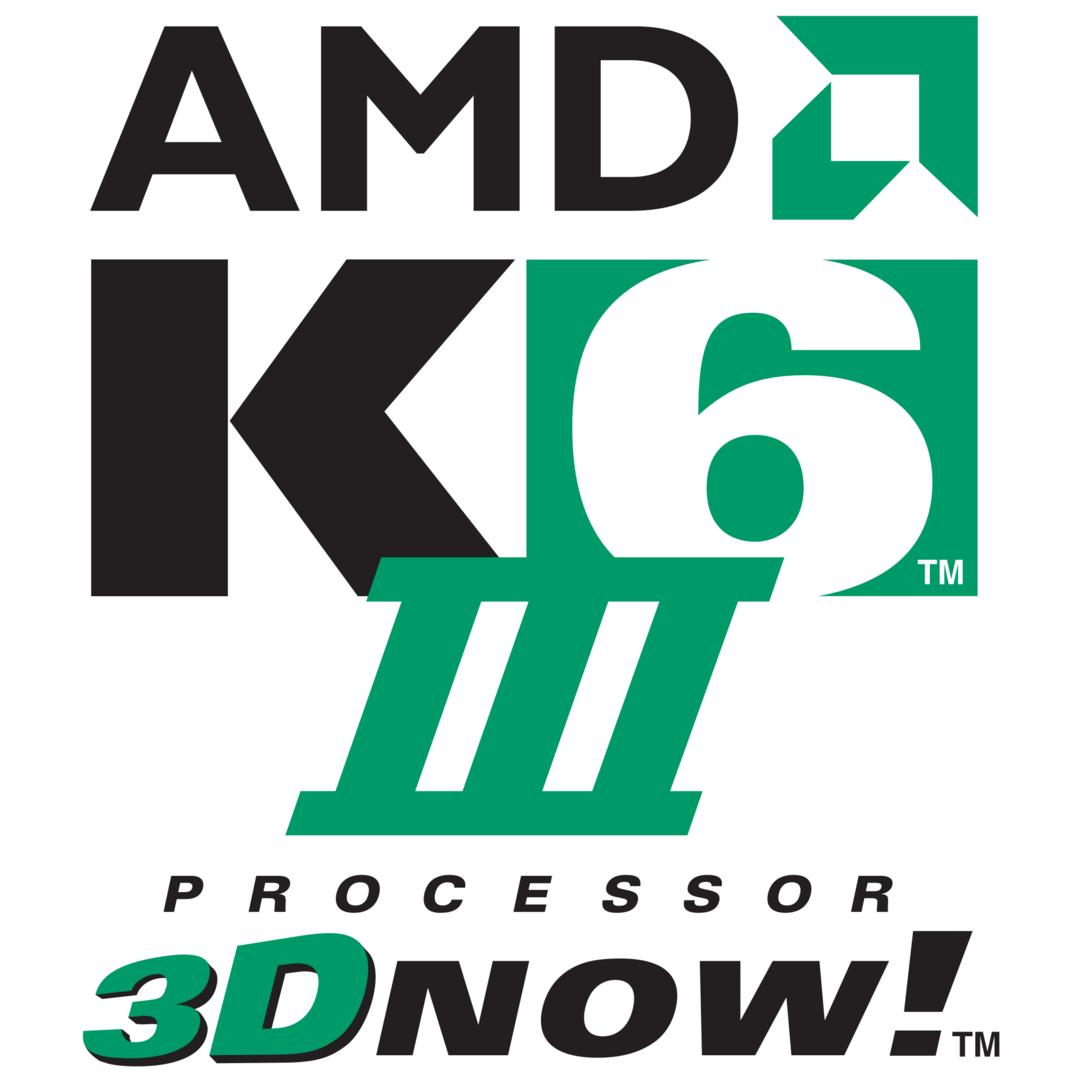 AMD K6-III (Image: AMD)
AMD K6-III (Image: AMD) As the last expansion stage of the K6 architecture and also as the basis for the K6-2 + and K6-III +, the AMD K6-III was able to come up with the following specifications before AMD focused all its efforts on the Athlon (“K7”).
specifications
Unlike its two predecessors, the K6 and K6-2, the K6-III and K6-III + had for the first time a 256 kilobyte L2 cache on the chip that was connected to the full CPU clock. The K6-2 +, which was not comparable to the K6-2 and was intended especially for notebooks, however, had 128 kilobytes of L2 cache.
The first K6-III were still produced in 250 nm, while the K6-2 + and the K6-III + already rolled off the production line in 180 nm in an advanced process developed energy saving function PowerNow! its way into the series of K6 processors.
(“Sharptooth”) 32 + 32 kilobytes
data + instructions 256 kilobytes
with full CPU speed 2.0 – 2.4 V 18.0 watt AMD K6-III-350 19.0 watt AMD K6-III-366 19.5 watt AMD K6-III-380 20.0 watt AMD K6-III-400 21.0 watt AMD K6-III-433 23.5 watts AMD K6-III-450 25.0 watts AMD K6-III-475 29.5 watts AMD K6-III + -400 K6-3D +
(“Sharptooth”) 32 + 32 kilobytes
data + instructions 256 kilobytes
with full CPU speed 2.0 ??? AMD K6-III + -450 ??? AMD K6-III + -500 ??? AMD K6-III + -550 ??? AMD K6-2 + -350 K6-3D +
(“Sharptooth”) 32 + 32 kilobytes
data + instructions 128 kilobytes
with full CPU speed 2.0 ??? AMD K6-2 + -400 AMD K6-2 + -450 AMD K6-2 + -475 AMD K6-2 + -500 AMD K6-2 + -550 AMD K6-2 + -570
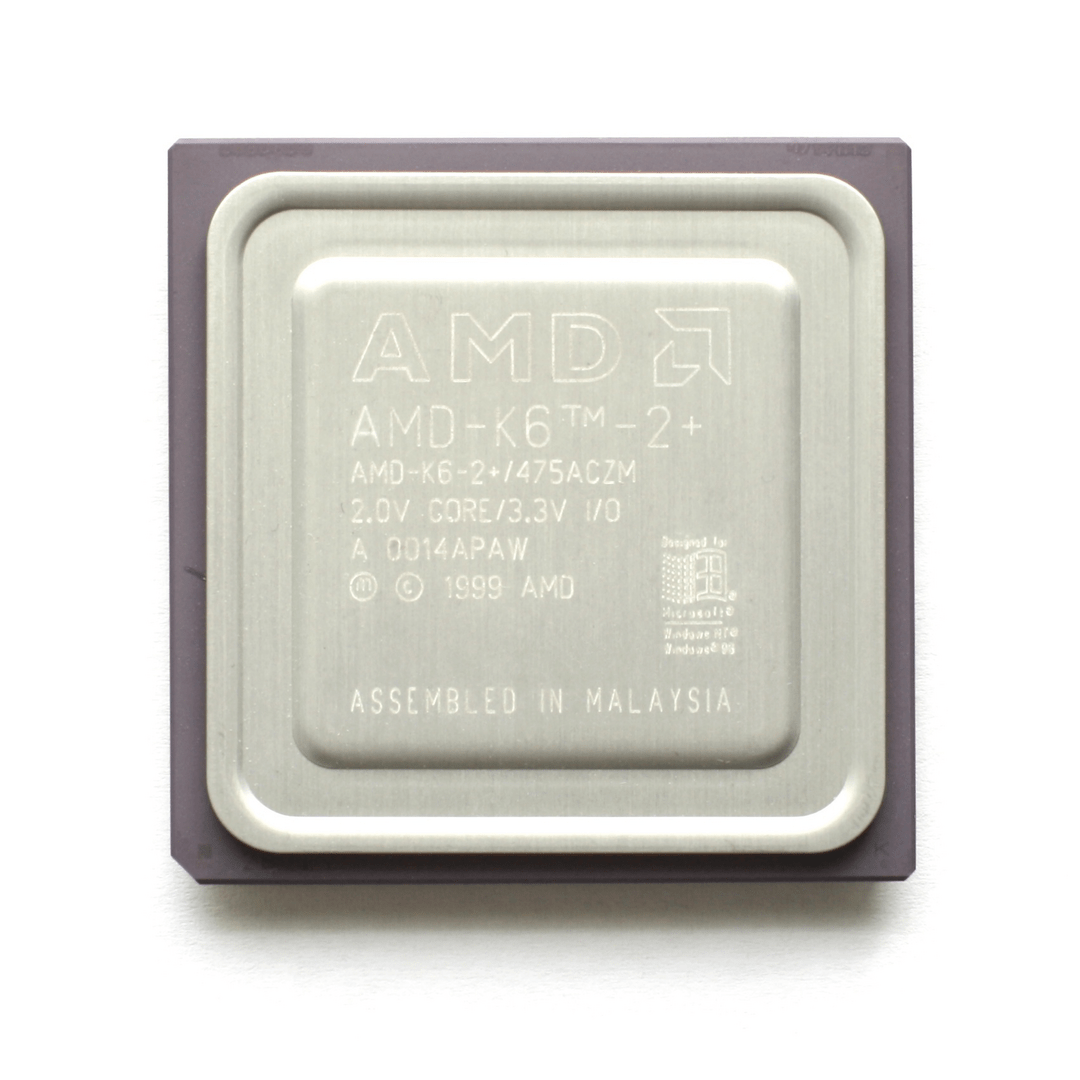 AMD K6-2 + (Image: Konstantin Lanzet , CC BY-SA 3.0)
AMD K6-2 + (Image: Konstantin Lanzet , CC BY-SA 3.0) 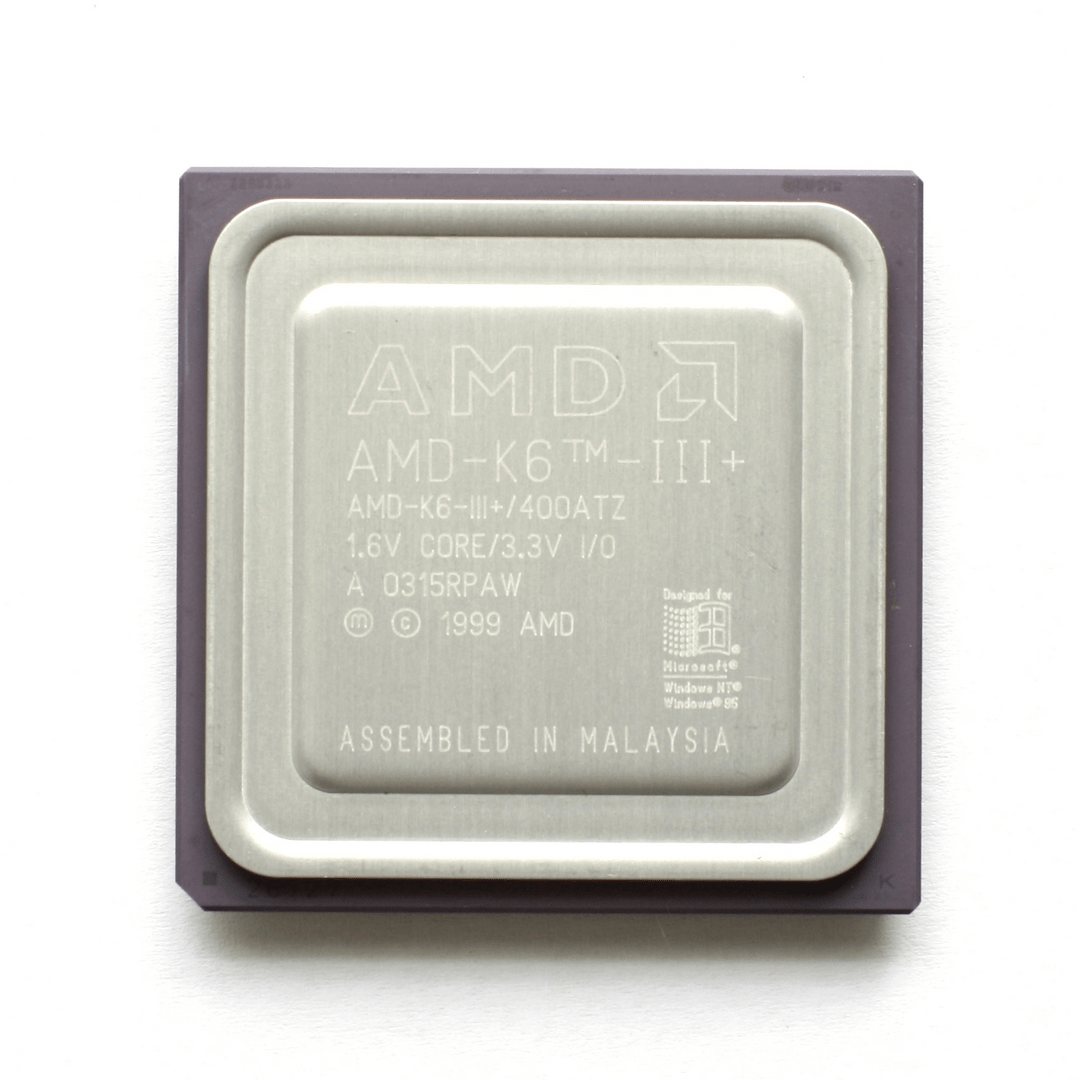 AMD K6-III + (Image: Konstantin Lanzet, CC BY-SA 3.0)
AMD K6-III + (Image: Konstantin Lanzet, CC BY-SA 3.0) With a maximum of 570 MHz in the K6-2 +, the K6 architecture literally ran out of steam at the beginning of the new millennium. The successor design K7, on the other hand, has scaled well beyond 2 GHz over the years.
The YouTube channel “PhilsComputerLab”, known for its high-quality retro content, lets an AMD K6-2 with 500 MHz compete against a Pentium II in one of its videos.
Even today, in particular, the first K6 and its predecessor, the AMD K5, serve as the basis for retro PCs with MS DOS, Windows 95 and designed for retro games Windows 98 very popular.
C: B_retro Feedback
Feedback is always welcome
The editors are happy to receive constructive criticism, praise, but also suggestions in order to be able to align the series even more closely to the wishes of the readership in the future. With this reading material in their luggage, the editors wish you a relaxing Sunday.
C: B_retro Review
The last fifteen issues in the overview
The last 15 topics of the previous issues of C: B_retro :
- C: B_retro Issue_92 : GeForce vs. Radeon in a duel of generations
- C: B_retro Issue_91 : Nintendo DS: One of the most successful game consoles in the world History
- C: B_retro Ausgabe_90 : The ideal gaming PC has been advising gamers for over 15 years
- C: B_retro Issue_89 : Your best games of all time have been selected
- C: B_retro Issue_88 : What are the best video games of all time?
- C: B_retro Edition_87 : The first IBM PC in the world defined standards
- C: B_retro Edition_86 : Microsoft Windows 96
- C: B_retro Edition_85 : AMD Phenom and Opteron ( “K10”)
- C: B_retro Issue_84 : FIFA Soccer and other football pioneers
- C: B_retro Issue_83 : Hercules 3D Prophet 4500 with PowerVR Kyro II
- C: B_retro Ausgabe_82 : ComputerBase builds the perfect Voodoo-2-Retro-PC
- C: B_retro Ausgabe_81 : The first graphics cards of the ComputerBase-Community
- C: B_retro Issue_80 : The early history of the graphics card
- C: B_retro Issue_79 : Nokia Communicator
- C: B_retro Issue_78 : The first Microsoft Xbox
Even more content of this kind and many more reports and anecdotes can be found in the retro corner of the ComputerBase forum as a Also in the subject areas C: B_retro and Retro.